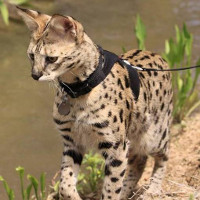 |
Savannah |
|
TranslationFrancis Vandersteen |
||
OriginThe Savannah is a breed of cat created in the United States in the late 1990s. |
| This large cat is the result of a cross between a male Serval and a domestic cat. |
A brief historical overview |
| The first Savannah, a female named “Savannah”, was created by breeder Judee Frank on April 7, 1986. Patrick Kelly, interested in wild-looking cats, decided to create a breed after having a female kitten, “Kitty”, from the first Savannah in 1989. He encouraged various breeders to try cross-breeding, but Joyce Sroufe was the only one to join him. They defined a standard and presented it to TICA in February 1996. A year later, Joyce Sroufe presented the Savannah at a cat show in Westchester, New York, and succeeded in obtaining the first fertile male Savannahs. In 2002, TICA considers the entry of this new breed on an equal footing with other domestic cats, but only for the third generation resulting from mating with the Serval, i.e. F1 and F2 generation hybrids cannot be accepted. The LOOF has authorized the breed to be shown since January 1, 2007 as a “New breeds and colors”, with wild cats and first- and second-generation hybrids (F1 and F2) banned from shows. The import of Savannah cats has been banned in Australia by the Minister for the Environment, Peter Garrett, due to the risks associated with the introduction of this hunter-talented breed, with Australia's twelve million hare cats already posing a major threat to wildlife. In the UK, the waiting time to own a Savannah kitten in 2009 was six months, at a price of over £6,000. |
General appearance |
| The Serval weighs between 15 and 20 kilos, while the domestic cat only weighs between 3 and 8. The Savannah resulting from this mix weighs between 7 and 14 kilos. It can measure up to forty centimetres (at the shoulder). The male is larger than the female. |
Behavior / characteristics |
| The Savannah is described as highly intelligent, curious, sociable, active, gentle and affectionate. It is said to be an excellent jumper and loves to play and get into the water. These characteristics, however, remain entirely individual and linked to each cat's history. |
Head |
||
Cranial region |
||
Head |
The head is small compared to the rest of the body. It is triangular in shape and longer than it is wide. | |
Facial region |
||
Nose |
Long nose and small chin. | |
Eyes |
Medium-sized, oval-shaped, slightly almond-shaped. They are often accompanied by the white tears characteristic of the breed. Color varies from yellow to golden green or amber. | |
Ears |
The ears are very large and set high on the head. They have a broad base and rounded tips. | |
Neck |
| The neck is very long, thick and muscular. |
Body |
Tail |
| Their tail is fairly thick and about 3/4 the length of a normal cat's. It has rings and ends in a rounded, black tip. It is ringed and ends in a rounded black tip. |
Limbs |
| The legs are long and slender, and the hind legs appear very high. | ||
Forequarters |
Hindquarters |
Feet |
| Small feet with long toes. |
Coat |
||
Coat and texture |
The coat is spotted tabby with several small black spots on the legs and head. These spots can be round, oval or elongated. The Savannah's entire belly is spotted and almost white. | |






 English (United Kingdom)
English (United Kingdom)